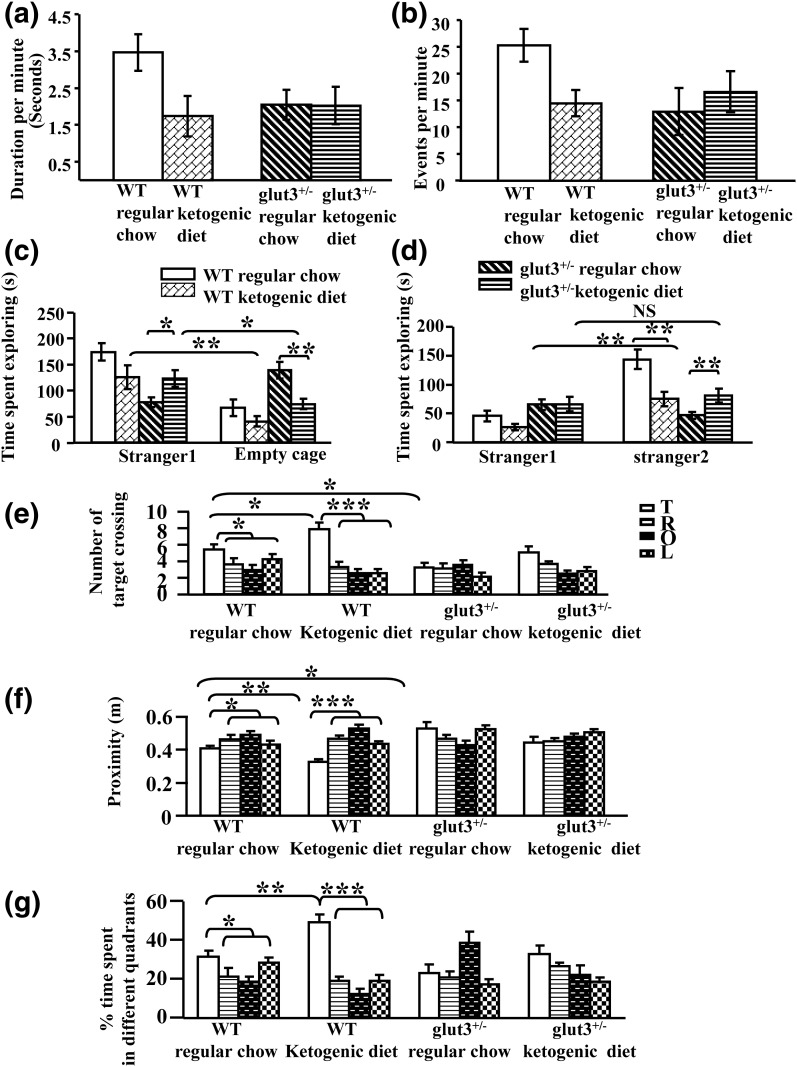Figure 6.
Neurobehavioral studies. Ultrasonic vocalization testing: ketogenic diet reduces vocalization as seen by decreased duration of vocalization per minute (0 to 6 minutes) (a) and vocalization events per minute (b) in WT mice but not in glut3+/− mice. WT male mice on regular chow (n = 38) or ketogenic diet (n = 7) and male glut3+/− mice on regular chow (n = 35) or ketogenic diet (n = 11). Sociability and social novelty: Glut3+/− genotype impaired social interaction (c). WT male mice on regular chow (n = 18) spent significantly more time exploring a conspecific than an empty cage in a social choice paradigm. WT-conspecific vs WT-empty cage: ***P < 0.001. Glut3+/− male mice on regular chow diet (n = 24), in contrast, spent more time exploring the empty cage than they spent interacting with the conspecific (**P < 0.004). Moreover glut3+/− mice spent significantly less time exploring the conspecific than WT controls (***P < 0.001), and therefore lacked normal levels of social exploration. A ketogenic diet significantly increased time spent interacting with the conspecific (*P < 0.05) and decreased the time exploring the empty cage (**P < 0.01), thus improving sociability in glut3+/− but not in WT male mice. In contrast, a ketogenic diet worsened the sociability in WT male mice (*P < 0.05 and **P < 0.01 respectively). n = 11 for WT on a ketogenic diet and n = 13 for glut3+/− mice on a ketogenic diet. Glut3+/− mice failed to show preference for the novel mouse in a social recognition task (d). WT: n = 18, ***P < 0.001; glut3+/−: n = 24, P = 0.106; time spent exploring unfamiliar mouse, WT vs glut3+/−: ***P < 0.001. A ketogenic diet significantly increased the time spent exploring the novel mouse, and therefore improved social novelty compared with familiar mouse in glut3+/− male mice (**P < 0.01). In contrast, a ketogenic diet significantly worsened social novelty in WT male mice (**P < 0.01). n = 11 for WT and n = 13 for glut3+/− mice both on a ketogenic diet. Morris water maze test examining spatial learning and memory: ketogenic diet increased spatial learning by enhancing number of target crossings (e), reducing proximity (f), and increasing time spent in the target quadrant (g) by WT male mice but not by glut3+/− male mice. WT mice on regular chow (n = 13) or ketogenic diet (n = 7) and glut3+/− mice on regular chow (n = 15) or ketogenic diet (n = 10), *P < 0.05 vs values in the target (T) quadrant in WT mice on regular chow diet. *P < 0.05, **P < 0.01, ***P < 0.001. L, left quadrant; O, opposite quadrant; R, right quadrant.

